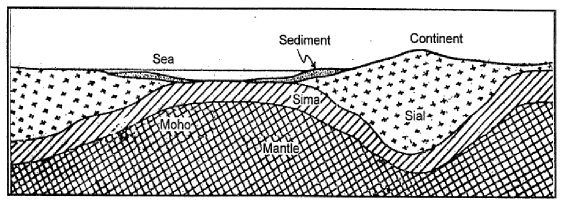Fig 6
3.1. The Crust
It is the earth’s uppermost layer. Crust is solid, rigid and very thin compared with the other two. Like the shell of an egg, the Earth's crust is brittle and can break. The thickness of the crust is not same everywhere.
Oceanic crust is thinner as compared to the continental crust. The mean thickness of oceanic crust is 5 km whereas that of the continental is around 30 km. The continental crust is thicker in the areas of major mountain systems. It is as much as 70 km thick in the Himalayan region.
Its two main parts are:
1. The uppermost thin layer– It is composed of such rocks which contain a large proportion of silica and aluminum. It is called SIAL (SI = Silica, AL = Aluminum). The continents are mostly composed of sial. It average density is 2.7 and thickness is of about 28 kilometers.
2. The lower layer of the crust is made of comparatively heavier rocks. Silica and magnesium are the major constituents in it. This part is therefore, known as SIMA (SI – Silicon, MA = Magnesium). The oceanic floor is also made of this rock strata. Its average thickness is 6-7 kilometers and density of about 3.0.
The thickness of SIAL and SIMA put together does not exceed 70 kilometers. Its volume is 1% of the total volume of the earth. In comparison to 6378 km radius of the earth, the thickness of 70 kilometers is insignificant. However, this cannot be over looked. This shallow crust is the ground of the nature’s wonderful activities.

